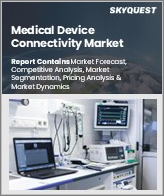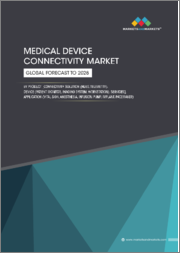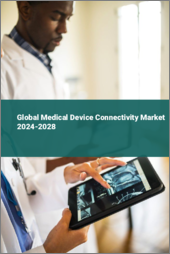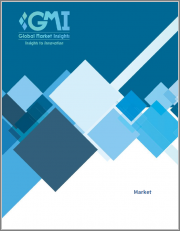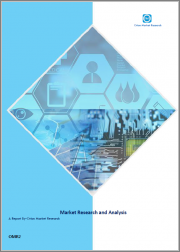
|
시장보고서
상품코드
1380383
세계 의료기기 커넥티비티 시장(2023년-2030년)Global Medical Devices Connectivity Market 2023-2030 |
||||||
세계 의료기기 커넥티비티 시장은 예측 기간 동안 복합 연간 성장률(CAGR) 18.5%의 대폭적인 성장이 예상되고 있습니다. 의료 인프라 디지털화의 진전, 의료 현장에서의 IoT 의료기기의 고집적화, 연결된 의료기기에 대한 높은 수요가 세계 의료기기 커넥티비티 시장의 성장을 가속하는 주요 요인이 되고 있습니다. 원격 의료 기술에 대한 높은 수요와 함께 EHR 및 의료 정보 교환 시스템의 도입이 증가하고 있는 것도 시장 성장에 더욱 기여하고 있습니다. HealthIT.Gov에 따르면 2021년 시점에서 사무실 기반 의사의 거의 5명 중 4명(78%), 연방 정부 이외의 비연방 병원의 거의 모두(96%)가 공인 EHR을 채택하고 있습니다. 이는 96%의 병원과 78%의 의사가 EHR을 도입한 2016년 이후 10년 만의 큰 진보입니다.
시장의 주요 기업은 시장에서의 존재를 확대하기 위해 신제품 출시 및 제휴에 적극적으로 노력하고 있습니다. 예를 들어, 2021년 10월, Royal Philips는 통합 및 상호 운용성을 가능하게 하는 장치 촉진요인인 Philipps Capsule Medical Device Information Platform(MDIP)을 출시했습니다. Philips 캡슐 MDIP는 Philips HealthSuite Platform에 통합되어 세계 3,000개 이상의 의료 시설에 도입되었습니다. Philips 캡슐 MDIP는 스트리밍 임상 데이터를 얻고 환자 관리 관리를 위한 실용적인 인사이트으로 전환하여 케어 팀 간의 협업을 개선하고, 임상 워크플로우를 간소화하고, 생산성을 향상시킵니다. 목표로합니다. 이러한 신흥국 시장의 개척이 세계 시장의 성장을 가속하고 있습니다. 그러나 연결 솔루션의 비용이 높아 세계 의료기기 커넥티비티 시장의 성장을 억제하고 있습니다. 의료기기 커넥티비티 서비스에서 5G 기술 도입 증가는 시장 성장에 유리한 기회를 제공할 것으로 예상됩니다.
부문별 전망
세계 의료기기 커넥티비티 시장에서는 병원이 큰 점유율을 차지
세계 의료기기 커넥티비티 시장에서 최종 사용자별로는 병원이 큰 점유율을 차지하고 있습니다. 이 높은 시장 점유율은 대규모 환자 풀의 존재, 첨단 의료기기 커넥티비티 솔루션을 구매하기 위한 병원의 높은 구매력, 병원에서의 이익 감소, 케어와 함께 높은 환자 안전을 제공하는 데 주목 증가에 기인합니다. 또한 환자의 지속적인 모니터링을 위해 병원에서 원격 환자 모니터링 기기의 고집적화가 이 시장 부문의 성장을 가속할 것으로 예상됩니다.
지역별 전망
세계 의료기기 커넥티비티 시장은 북미(미국과 캐나다), 유럽(이탈리아, 스페인, 독일, 프랑스 등), 아시아태평양(인도, 중국, 일본, 한국, 기타), 세계 기타 지역(중동 및 아프리카, 라틴아메리카) 지역별로 더욱 세분화되어 있습니다. 모든 지역 중에서 아시아태평양은 예측 기간 동안 상당한 복합 연간 성장률(CAGR)로 성장할 것으로 예측됩니다.
북미가 세계 의료기기 커넥티비티 시장에서 큰 점유율을 획득
첨단 의료 IT 인프라의 존재, 연결된 의료기기의 높은 보급률, 높은 의료비가 이 지역 시장의 높은 점유율의 주요 요인이 되고 있습니다. 이 지역에는 이 분야에서 지속적으로 노력하고 있는 주요 시장 기업이 존재하며, 이 지역 시장의 성장에 더욱 기여하고 있습니다. 예를 들어, 2023년 4월 의료 인공지능(AI) 솔루션 기업인 Vuno는 AI 기반 의료 영상 분석 기술로 미국 특허를 취득했습니다. 이 특허는 임상 환경에서 X 선, 자기 공명 영상 스캔, 컴퓨터 단층 촬영(CT) 스캔과 같은 의료 영상을 검사 할 때 의료 종사자가 확인한 병변 부위를 수정하는 과정을 단순화한다 목적으로 한 기술에 관한 것입니다.
게다가 2021년 6월에는 15개 이상의 초전문병원, 진단, 통합 재택 케어 서비스를 전개하는 인도 최대급의 헬스 케어 프로바이더인 맥스 헬스 케어가 인공지능(AI)을 활용했다 장치 통합형 환자 모니터링 프레임워크를 시작했습니다. Max Healthcare는 디지털 건강 솔루션 제공업체인 My Health Care와 공동으로 이 서비스를 시작했습니다.
목차
제1장 보고서 개요
- 업계의 현황 분석과 성장 잠재력의 전망
- 조사 방법과 도구
- 시장 분석
- 부문별
- 지역별
제2장 시장 개요와 인사이트
- 조사 범위
- 분석가의 인사이트와 현재 시장 동향
- 주요 조사 결과
- 추천 사항
- 결론
제3장 경쟁 구도
- 주요 기업 분석
- Capsule Technologies, Inc.
- 개요
- 재무 분석
- SWOT 분석
- 최근 동향
- Cerner Corp.
- 기업 개요
- 재무 분석
- SWOT 분석
- 최근 동향
- Cisco Systems Inc.
- 개요
- 재무 분석
- SWOT 분석
- 최근 동향
- GE Healthcare
- 개요
- 재무 분석
- SWOT 분석
- 최근 동향
- Infosys Ltd.
- 개요
- 재무 분석
- SWOT 분석
- 최근 동향
- 주요 전략 분석
제4장 시장 세분화
- 세계 의료기기 커넥티비티 시장 : 컴포넌트별
- 솔루션
- 서비스
- 세계 의료기기 커넥티비티 시장 : 기술별
- 유선
- 무선
- 하이브리드
- 세계 의료기기 커넥티비티 시장 : 최종사용자별
- 병원
- 외래의료센터
- 기타(클리닉)
제5장 지역별 분석
- 북미
- 미국
- 캐나다
- 유럽
- 영국
- 독일
- 이탈리아
- 스페인
- 프랑스
- 기타 유럽
- 아시아태평양
- 중국
- 인도
- 일본
- 한국
- 기타 아시아태평양
- 세계 기타 지역
제6장 기업 프로파일
- Ascom Holdings AG
- Bridge-Tech Medical
- Dragerwerk AG& CO. KGAA
- Hil-Rom Holdings, Inc.
- Ihealth Lab
- Infosys Ltd.
- Koninklijke Philips NV
- Lantronix, Inc.
- Medicollector LLC
- NantHealth, Inc.
- S3 Connected Health
- Silex technology
- Spectrum Medical Ltd.
- Stryker Corp.
- Wipro Ltd.
Title: Global Medical Devices Connectivity Market Size, Share & Trends Analysis Report, By Component (Solution, Services) By Technology (Wired, Wireless, Hybrid), By End-User (Hospitals, Ambulatory Care Centers, Other),Forecast Period (2023-2030).
The global medical devices connectivity market is anticipated to grow at a significant CAGR of 18.5% during the forecast period. The growing digitalization of healthcare infrastructure, high integration og IoT medical devices in healthcare settings, and high demand for connected medical devices is a key factor driving the growth of the global medical device's connectivity market. The rising implementation of EHRs and health information exchange systems along with the high demand for telemedicine technologies is further contributing to the market growth. According to HealthIT.Gov, as of 2021, nearly 4 in 5 office-based physicians (78%) and nearly all non-federal acute care hospitals (96%) adopted a certified EHR. This marks substantial 10-year progress since 2016 when 96% of hospitals and 78% of physicians had adopted an EHR.
The key market players are actively involved in new product launches and collaborations to expand their presence in the market. For instance, in October 2021, Royal Philips launched device drivers that enable integration and interoperability, Philips Capsule Medical Device Information Platform (MDIP). Philips Capsule MDIP integrated into the Philips HealthSuite Platform, installed in more than 3,000 healthcare facilities globally. Philips Capsule MDIP captures streaming clinical data and transforms it into actionable insights for patient care management, aiming to improve collaboration between care teams, streamline clinical workflows, and increase productivity. Such ongoing market developments are promoting the global market growth. However, the high cost of connectivity solutions restrains the growth of the global medical devices connectivity market. The rising implementation of 5G technologies in the medical device connectivity services is anticipated to offer lucrative opportunities to the market growth.
Segmental Outlook
The global medical devices connectivity market is segmented based on component, technology, and end-user. Based on component, the market is segmented into solution and services. Based on technology, the market is segmented into wired, wireless, and hybrid. Based on end-user, the market is segmented into hospitals, ambulatory care centers, and others.
Hospitals Held Considerable Share in Global Medical Devices Connectivity Market
Hospitals held considerable share in the global medical devices connectivity market based on end-user. The high market share can be attributed to the presence of large patient pool, high purchasing power of hospitals to purchase advanced medical device connectivity solutions, decreasing margins in hospitals, and rising focus on delivery high patient safety with care. Additionally, the high integration remote patient monitoring devices in hospitals for the continuous monitoring of patients is anticipated to drive the growth of this market segment.
Regional Outlook
The global medical devices connectivity market is further segmented based on geography, including North America (the US and Canada), Europe (Italy, Spain, Germany, France, and others), Asia-Pacific (India, China, Japan, South Korea, and others), and the Rest of the World (the Middle East & Africa and Latin America). Among all regions, the Asia-Pacific region is anticipated to grow at a considerable CAGR over the forecast period.
North America Held Considerable Share in the Global Medical Devices Connectivity Market
The presence of advanced healthcare IT infrastructure, high penetration of connected medical devices along with high healthcare expenditure is a key contributor to the high share of the regional market. The presence of key market players across the region that are continuously working towards this segment is further contributing to the regional market growth. For instance, in April 2023, Medical artificial intelligence (AI) solution company Vuno has received a US patent for its AI-based medical image analysis technology. This patent pertains to a technology aimed at simplifying the process of correcting lesion areas identified by medical personnel during the examination of medical images such as X-rays, magnetic resonance imaging scans and computerized tomography (CT) scans in clinical environments.
Market Players Outlook
The major companies serving the global medical devices connectivity market include: Capsule Technologies, Inc., Cerner Corp., Cisco Systems Inc., GE Healthcare, and Infosys Ltd. among others. The market players are considerably contributing to the market growth by the adoption of various strategies, including mergers and acquisitions, partnerships, collaborations, funding, and new product launches, to stay competitive in the market. For instance, in October 2022, BD (Becton, Dickinson and Company) a medical technology company, and Biocorp (Paris:ALCOR), a medical device and delivery systems manufacturer based in France have signed an agreement with the aim of using connected technology to track adherence for self-administered drug therapies, like biologics. Biocorp's Injay is a simple and cost-effective connected solution designed to monitor the use of pre-fillable syringes in clinical studies or routine care. Through NFC technology and specific sensors to identify the product, it can confirm a complete injection and easily transfer that information to a smartphone.
Additionally, in June 2021, Max Healthcare, one of the largest healthcare providers in India with over 15 super specialty hospitals, diagnostics and integrated home care services, has launched an artificial intelligence (AI) powered device integrated patient monitoring framework. Max Healthcare has launched the service in collaboration with digital health solutions provider MyHealthcare.
The Report Covers:
- Market value data analysis of 2022 and forecast to 2030.
- Annualized market revenues ($ million) for each market segment.
- Country-wise analysis of major geographical regions.
- Key companies operating in the global medical devices connectivity market. Based on the availability of data, information related to new product launches, and relevant news is also available in the report.
- Analysis of business strategies by identifying the key market segments positioned for strong growth in the future.
- Analysis of market-entry and market expansion strategies.
- Competitive strategies by identifying 'who-stands-where' in the market.
Table of Contents
1. Report Summary
- Current Industry Analysis and Growth Potential Outlook
- 1.1. Research Methods and Tools
- 1.2. Market Breakdown
- 1.2.1. By Segments
- 1.2.2. By Region
2. Market Overview and Insights
- 2.1. Scope of the Report
- 2.2. Analyst Insight & Current Market Trends
- 2.2.1. Key Findings
- 2.2.2. Recommendations
- 2.2.3. Conclusion
3. Competitive Landscape
- 3.1. Key Company Analysis
- 3.2. Capsule Technologies, Inc.
- 3.2.1. Overview
- 3.2.2. Financial Analysis
- 3.2.3. SWOT Analysis
- 3.2.4. Recent Developments
- 3.3. Cerner Corp.
- 3.3.1. Overview
- 3.3.2. Financial Analysis
- 3.3.3. SWOT Analysis
- 3.3.4. Recent Developments
- 3.4. Cisco Systems Inc.
- 3.4.1. Overview
- 3.4.2. Financial Analysis
- 3.4.3. SWOT Analysis
- 3.4.4. Recent Developments
- 3.5. GE Healthcare
- 3.5.1. Overview
- 3.5.2. Financial Analysis
- 3.5.3. SWOT Analysis
- 3.5.4. Recent Developments
- 3.6. Infosys Ltd.
- 3.6.1. Overview
- 3.6.2. Financial Analysis
- 3.6.3. SWOT Analysis
- 3.6.4. Recent Developments
- 3.7. Key Strategy Analysis
4. Market Segmentation
- 4.1. Global Medical Devices Connectivity Market by Component
- 4.1.1. Solutions
- 4.1.2. Services
- 4.2. Global Medical Devices Connectivity Market by Technology
- 4.2.1. Wired
- 4.2.2. Wireless
- 4.2.3. Hybrid
- 4.3. Global Medical Devices Connectivity Market by End-User
- 4.3.1. Hospitals
- 4.3.2. Ambulatory Care Centers
- 4.3.3. Others (Clinics)
5. Regional Analysis
- 5.1. North America
- 5.1.1. United States
- 5.1.2. Canada
- 5.2. Europe
- 5.2.1. UK
- 5.2.2. Germany
- 5.2.3. Italy
- 5.2.4. Spain
- 5.2.5. France
- 5.2.6. Rest of Europe
- 5.3. Asia-Pacific
- 5.3.1. China
- 5.3.2. India
- 5.3.3. Japan
- 5.3.4. South Korea
- 5.3.5. Rest of Asia-Pacific
- 5.4. Rest of the World
6. Company Profiles
- 6.1. Ascom Holdings AG
- 6.2. Bridge-Tech Medical
- 6.3. Dragerwerk AG& CO. KGAA
- 6.4. Hil-Rom Holdings, Inc.
- 6.5. Ihealth Lab
- 6.6. Infosys Ltd.
- 6.7. Koninklijke Philips N.V.
- 6.8. Lantronix, Inc.
- 6.9. Medicollector LLC
- 6.10. NantHealth, Inc.
- 6.11. S3 Connected Health
- 6.12. Silex technology
- 6.13. Spectrum Medical Ltd.
- 6.14. Stryker Corp.
- 6.15. Wipro Ltd.






